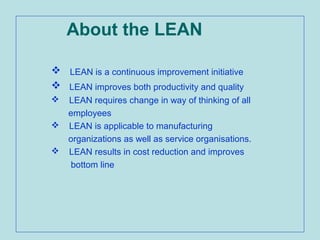LEAN
- 1. LEAN A presentation by THE SOCIETY OF STATISTICAL QUALITY CONTROL ENGINEERS BHOPAL
- 3. LEAN: Definition LEAN is a set of practices that consider the expenditure of resources for any goal other than the creation of value for the end customer to be wasteful and therefore to be eliminated. LEAN is a systematic approach to identifying and eliminating non-valve-adding activities (waste) and achieving work flow by the “pull” of the customer. Originally developed as a production/ manufacturing practice by Toyota, now, LEAN principles have proved equally beneficial to service sector too. In short, LEAN thinking is LEAN because it provides a way to do more and more with less and less human effort, less human equipment, less time, and less space; while coming closer and closer to providing customers with exactly what they want.
- 4. About the LEAN LEAN is a continuous improvement initiative LEAN improves both productivity and quality LEAN requires change in way of thinking of all employees LEAN is applicable to manufacturing organizations as well as service organisations. LEAN results in cost reduction and improves bottom line
- 5. LEAN OBJECTIVES Eliminate non-value-adding activities Identify and eliminate waste at every stage of product/service
- 6. ABOUT VALUE 1) Value is a set of attributes of a product ( or service) specified or expected by the ultimate customer for a given price. 2) Value-adding activities are those activities that change the form or functions of the product . 3) Non-value-adding activities are those activities that do not change the form or functions of the product. 4) LEAN requires value based design and production 5) What prevents defining value: i) Most producers want to make what they have been making ii) Most customers only know how to ask for some variant of what they are already getting. iii) Lack of interaction between producer and customer on value aspects 6) Experience over the years shows that we focus more towards accelerating value-adding activities than eliminating non-value adding activities.
- 7. EXAMPLES Value adding activities - Casting - Machining - Assembly - Painting Non- value adding activities - Handling - Transportation - Storage - Waiting - Rework
- 8. THE QUALITY PERSPECTIVE OF LEAN As LEAN is characterized by smooth work flow and minimum or no inventories, any quality deficiency in the product /process “surfaces” readily and timely corrective action becomes mandatory. Therefore LEAN results in: i) Making things right first time ii) All machines in good working condition LEAN therefore improves quality too!
- 9. LEAN FOCUS LEAN is focused on getting the right things to the right place, at the right time in the right quantity to achieve perfect work flow while minimizing waste.
- 10. LEAN IMPLEMENTATION A Three pronged strategy 1) Eliminate waste (Muda) at every stage 2) Make workflow smooth by removing obstacles/ un-evenness (Mura) in the system. 3) Avoid imposing unreasonable work (Muri) on workers and machines.
- 11. Removing Muda: Seven wastes 1) Over production 2) Excess inventory 3) Un-necessary processing 4) Un-necessary motion of people/equipment 5) Un-necessary transportation 6) Defects 7) Waiting
- 12. WHAT IS OVER PRODUCTION (1) Making more than is needed by the next process/customer (2) Making earlier than is needed by the next process/customer (3) Making faster than is needed by the next process/customer
- 13. WHY REDUCE INVENTORY 1) Money invested in inventory could be used more productively elsewhere. 2) Storage of inventory costs, particularly, if the storage is to be done in a controlled environment. 3) Quality of product may deteriorate during storage. 4) Product deficiency, if any, is detected without delay
- 14. Removing Mura (unevenness) Unevenness in work flow causes pile-up of inventories of material/WIP/product Reduce unevenness (Mura) by such measures as manpower re-distribution/ multi skilling/ reduction in batch size/ SMED /line balancing/ production leveling. There should be no blockage in the material flow as well as information flow
- 15. Removing Muri (overburden) Muri is all the unreasonable work that is imposed on workers and machines such as carrying weights heavier than permitted or forcing to work significantly faster than usual. It is pushing persons or machines beyond their natural limits. It is asking a greater level of performance from a process than it can handle without taking shortcuts. Experience has shown that Muri causes frequent breakdowns and deficiencies in products/processes which ultimately hinder smooth workflow. Hence Muri is to be removed at every stage.
- 16. LEAN IMPLEMENTATION: STEPS INVOLVED 1) Value stream mapping for the present state 2) Identification of bottleneck processes and inventory build-up locations 3) Deciding on remedial measures: a) Kanban approach b) Workcell approach c) Batchsizing approach 4) Value stream mapping for the future state 5) Implementation to realize future state value stream
- 17. COMMON LEAN TOOLS LEAN TOOL APPLICATION Value stream mapping Gives a good understanding of material flow, information flow, bottlenecks and inventory build- ups Kanban Production and withdrawal kanbans (visual displays) help operate “pull” system. Workcell layout Reduces cycle time for small and repetitive items. Reduces multiple waiting time. Batch sizing/SMED * Helps balance production line. Reduces inventory build-ups Standardized work Optimizes cycle time and results in consistent quality and delivery. * SMED: Single Minute Exchange of Dies
- 18. CONVENTIONAL THINKING Vs LEAN THINKING CONVENTIONAL THINKING LEAN THINKING Man and Machine utilization is important Value addition is important Performance is judged by “numbers” Performance is judged by “smoothness” of workflow Production is based on market forecasts Production is based on customer demands Work flows due to “push” from the preceding stage/supplier Work flows by customer “pull” Heap of materials/products/WIP in the factory indicates lot of work being done Heavy inventories are a clear sign of poor work flow and low productivity. Good working is characterized by visible motion of men and machines. Cut down unproductive motion of men and machines so that efforts, thus saved, can be utilized for enhancing productivity



















